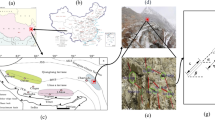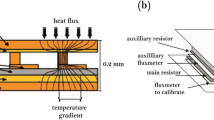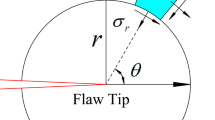Abstract
Concrete hollow cylinders subjected to combined compression and torsion were used to simulate concrete airport pavements subjected to biaxial fatigue loading in the compression region. It was found that the increase in the compliance in the post-peak period is due to the damage evolution of the specimen. The static failure mechanisms was explained by fracture mechanics. Similar failure was observed in fatigue loading. It was found that with the crack growth as a parameter, the static response acts as an envelope for the fatigue failure response. The rate of the crack growth under fatigue loading follows a two-stage process: a deceleration stage followed by an acceleration stage up to failure. In the deceleration stage, the growth is governed by the R-curve of the specimen. In the acceleration stage, it is governed by the Paris Law. The previously proposed model in the biaxial tension region was extended to the biaxial compression region. In the biaxial compression region, static and fatigue behaviors under pure compressive loading were modelled in terms of inelastic displacement, rather than crack length.
Résumé
Afin de simuler le comportement des dalles de béton sur les plates-formes aéroportuaires, ces dernières étant soumises à des chargements cycliques biaxiaux tels que la contrainte principale de compression est supérieure à la contrainte principale de tension, des cyclindres creux en béton ont été chargés en compression (suivant un axe longitudinal) et en torsion combinées. Il a ainsi été trouvé que l'augmentation de la souplesse dans la partie post-pic s'explique par une évolution de la détérioration mécanique du spécimen. Le mécanisme de rupture en mode statique a été expliqué par la théorie classique de mécanique de rupture. Un type de rupture similaire a été observé en chargement cyclique. En adoptant comme paramètre la longueur de fissure, la réponse statique du spécimens représente une courbe-enveloppe de la réponse au chargement cyclique. Le taux d'accroissement de la longueur de fissure sous chargement cyclique obéit à un processus en deux temps: une phase de décélération obéissant à la courbe R du spécimen puis une phase d'accélération obéissant à la loi de Paris. Le modèle antérieur, établi dans le cas où la contrainte principale dominante est la tension, a été étendu au cas où la compression domine comme contrainte principale. Les comportements statique et sous chargement cyclique en compression pure ont été modélisés en termes de déplacements inélastiques plutôt qu'en termes d'accroissement de la longueur de fissure.
Similar content being viewed by others
References
ACI Committee 215,Fatigue of Concrete Structures, SP-75, S.P. Shah, ed., American Concrete Institute, Detroit (1982).
RILEM Committee 36-RDL, ‘Long term random dynamic loading of concrete structures’,Mater. Struct. 17 (9) (1984) 1–28.
Paskova, T., and Meyer, C., ‘Optimum number of specimens for low-cycle fatigue tests of concrete’,Journal of Structural Engineering 120 (7) (1994) 2242–2247.
Bažant, Z.P. and Xu, K., ‘Size effect in fatigue fracture of concrete’,ACI Materials Journal 88 (4) (1991) 390–399.
Bažant, Z.P. and Schell, W.F., ‘Fatigue fracture of high strength concrete and size effect’,ACI Materials Journal 90 (5) (1993) 472–478.
Hordijk, D.A. and Reinhardt, H.W., ‘Numerical and experimental investigation into the fatigue behavior of plain concrete’,Experimental Mechanics 83 (4) (1993) 278–285.
Kupfer, H.B. and Gerstle, K.H., ‘Behavior of concrete under biaxial stresses’,Journal of Engineering Mechanics, ASCE 99 (4) (1973) 853–866.
Kupfer, H.B., Hilsdorf, H. and Rusch, H., ‘Behavior of concrete under biaxial stresses’,ACI Materials Journal 66 (8) (1969) 656–666.
Shah, S.P., ‘Fracture toughness of cement-based materials’,Mater. Struct.,21 (122) (1988) 145–150.
Subramaniam, K. V., Popovics, J.S. and Shah, S.P., ‘Fatigue fracture of concrete subjected to biaxial stresses in the tensileC-T region’,Journal of Engineering Mechanics, ASCE 128 (6) (2002) 668–676.
Subramaniam, K.V., O'Neil, E., Popovics, J.S. and Shah, S.P., ‘Flexural fatigue of concrete: experiments and theoretical model’,Journal of Engineering Mechanics, ASCE 126 (9) (2000) 891–898.
Subramaniam, K.V., ‘Fatigue of concrete subjected to biaxial loading in the tension region’, PhD dissertation, Northwestern University, Evanston, IL (1999).
Subramaniam, K.V., Popovics, J.S. and Shah, S.P., ‘Fatigue behavior of concrete subjected to biaxial stresses in the compression-tension region’,ACI Materials Journal 96 (6) (1999) 663–669.
Subramaniam, K.V., Popovics, J.S. and Shah, S.P., ‘Testing concrete in torsion: instability analysis and experiments’,Journal of Engineering Mechanics, ASCE 124 (11) (1998) 1258–1268.
Mu, B., Subramaniam, K.V. and Shah, S.P., ‘Failure mechanism of concrete under fatigue compressive load’,Journal of Materials in Civil Engineering (2003) accepted (MT/2003/022651).
Okubo, S. and Nishimatsu Y, ‘Uniaxial compression testing using a linear combination of stress and strain as the control variable’,International Journal of Rock Mech. Min. Sci. & Geomech. Abstr.,22 (5) (1985) 323–330.
Bažant, Z.P., ‘Identification of strain-softening constitutive relation from uniaxial tests by series coupling model localization’,Cement and Concrete Research 19 (6) (1989) 973–977.
Shah, S.P. and Sankar, R., ‘Internal cracking and strain-softening response of concrete under uniaxial compression’,ACI Materials Journal 84 (3) (1987) 200–212.
Torrenti, J.M., Benaija, E.H. and Boulay, C., ‘Influence of boundary conditions on strain softening in concrete compression test’,Journal of Engineering Mechanics, ASCE 119 (12) (1993) 2369–2384.
Jansen, D.C. and Shah, S.P., ‘Effect of length on compressive strain softening of concrete’,Journal of Engineering Mechanics, ASCE 123 (1) (1997) 25–35.
Nelissen, L.M.J., ‘Biaxial testing of normal concrete’,Heron (Delft)18 (1) (1972).
Author information
Authors and Affiliations
Additional information
Editorial Note Prof. Dr. surendra P. Shah is a member of the Bureau of RILEM as well as the Editor-in-Chief ofMaterials and Structures. ACBM Center (Northwestern University) is a RILEM Titular Member.
Rights and permissions
About this article
Cite this article
Mu, B., Shah, S.P. Fatigue behavior of concrete subjected to biaxial loading in the compression region. Mat. Struct. 38, 289–298 (2005). https://doi.org/10.1007/BF02479293
Received:
Accepted:
Issue Date:
DOI: https://doi.org/10.1007/BF02479293




